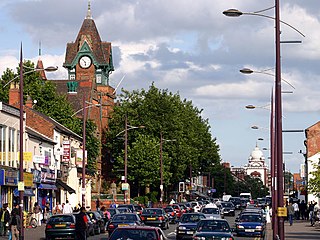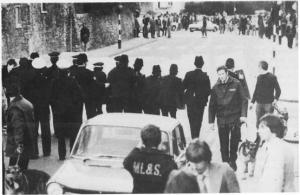Related Research Articles

Toxteth is an inner-city area of Liverpool in the county of Merseyside.
In England and Wales, the sus law was a stop and search law that permitted a police officer to stop, search and potentially arrest people on suspicion of them being in breach of section 4 of the Vagrancy Act 1824. According to a 2018 study in the British Journal of Criminology, stop and search had a marginal impact on crime in the UK.

Handsworth is an inner-city area of Birmingham in the West Midlands, England. Historically in Staffordshire, Handsworth lies just outside Birmingham City Centre and near the town of Smethwick.

The 1981 Brixton riot, or Brixton uprising, was a series of clashes between mainly black youths and the Metropolitan Police in Brixton, London, between 10 and 12 April 1981. It resulted from racist discrimination against the black community by the mainly white police, especially the police's increased use of stop-and-search in the area, and ongoing tensions resulting from the deaths of 13 black teenagers and young adults in the suspicious New Cross house fire that January. The main riot on 11 April, dubbed "Bloody Saturday" by Time magazine, resulted in 279 injuries to police and 45 injuries to members of the public; over a hundred vehicles were burned, including 56 police vehicles; almost 150 buildings were damaged, thirty of which were burnt out, and many shops were looted. There were 82 arrests. Reports suggested that up to 5,000 people were involved. The Brixton riot was followed by similar riots in July in many other English cities and towns. The Thatcher government commissioned an inquiry, which resulted in the Scarman Report.
The Brixton riot of 1985 started on 28 September in Lambeth in South London. It was the second major riot that the area had witnessed in the space of four years, the last in 1981. It was sparked by the shooting of Dorothy "Cherry" Groce by the Metropolitan Police, while they sought her 21-year-old son Michael Groce in relation to a robbery and suspected firearms offence; they believed Michael Groce was hiding in his mother's home.

The Broadwater Farm riot occurred on the Broadwater council estate in Tottenham, North London, on 6 October 1985.
The Scarman report was commissioned by the UK Government following the 1981 Brixton riots. Lord Scarman was appointed by then Home Secretary William Whitelaw on 14 April 1981 to hold the enquiry into the riots. The Scarman report was published on 25 November 1981.
The Toxteth riots of July 1981 were a civil disturbance in Toxteth, inner-city Liverpool, which arose in part from long-standing tensions between the local police and the black community. They followed the Brixton riot earlier that year and were part of the 1981 England riots.

The St Pauls riot occurred in St Pauls, Bristol, England on 2 April 1980 when police raided the Black and White Café on Grosvenor Road in the heart of the area. After several hours of disturbance in which fire engines and police cars were damaged, 130 people were arrested, 25 were taken to hospital, including 19 police and members of the press.
The Notting Hill race riots were a series of racially motivated riots that took place in Notting Hill, a district of London, the capital city of the United Kingdom between 29 August and 5 September 1958.
The Bristol riots refer to a number of significant riots in the city of Bristol in England.
Riots often occur in reaction to a perceived grievance or out of dissent. Riots may be the outcome of a sporting event, although many riots have occurred due to poor working or living conditions, government oppression, conflicts between races or religions.
Sir Kenneth Gordon Oxford was a senior British police officer and chief constable of Merseyside Police from 1976 to 1989.
In July 1981, the inner-city district of Moss Side in Manchester, England, was the scene of mass protesting. The protests at Moss Side started at the local police station and later moved into the surrounding streets over two days. Key factors seen as fuel for this protest were racial tension, due to frequent allegations of police officers racially abusing and using excessive force against black youths in the area, and mass unemployment brought on by the early 1980s recession. Unemployment was at a post-war high across the nation during 1981, but was much higher than the national average in Moss Side.

The 2011 England riots, more widely known as the London riots, were a series of riots between 6 and 11 August 2011. Thousands of people rioted in cities and towns across England, which saw looting and arson, as well as mass deployment of police and the deaths of five people.
The 1981 Handsworth riots were three days of rioting that took place in the Handsworth area of Birmingham, England in July 1981. The major outbreak of violence took place on the night of Friday 10/11 July, with smaller disturbances on the following two nights.

The second Handsworth riots took place in the Handsworth district of Birmingham, West Midlands, from 9 to 11 September 1985. The riots were reportedly sparked by the arrest of a man near the Acapulco Cafe, Lozells and a police raid on the Villa Cross public house in the same area. Hundreds of people attacked police and property, looting and smashing, even setting off fire bombs.
The Chapeltown Riots of 1981 took place in the Leeds district of Chapeltown in West Yorkshire, England, during a time when many other areas of the UK were suffering similar problems. The riots unfolded in July 1981 from a background of racial tension, inner city poverty, poor housing and high unemployment. This brought high tension, particularly amongst the area's Caribbean community, culminating in attacks on the local police.
Liverpool-born Black people are those of Black African ancestry born in the city of Liverpool. Liverpool has the United Kingdom's oldest and longest established black community, going back several generations. Liverpool's black community is also unusual among those in the United Kingdom, as the Liverpool-born Black British community often constitute a category distinct from later African and Afro-Caribbean migrants.
References
- 1 2 "How smouldering tension erupted to set Brixton aflame". The Guardian . London. 13 April 1981.
- ↑ J. A. Cloake & M. R. Tudor. Multicultural Britain. Oxford University Press, 2001. pp. 60–64
- ↑ Kettle, Martin & Hodges, Lucy (1982) Uprising!: Police, the People and the Riots in Britain's Cities
- 1 2 "Q&A THe Scarman Report". BBC News. 20 April 2004.
- ↑ John, Cindi (5 April 2006). "The legacy of the Brixton riots". BBC News. Retrieved 20 April 2013.
- ↑ "UK Inflation History by month: 1976 – 1995". swanlowpark. Archived from the original on 11 October 2011. Retrieved 11 August 2011.
- ↑ "Economics Essays: UK Economy under Mrs Thatcher 1979–1984". Econ.economicshelp.org. Retrieved 11 October 2010.
- 1 2 3 "Policing the riots: from Bristol and Brixton to Tottenham, via Toxteth, Handsworth, etc | Centre for Crime and Justice Studies". www.crimeandjustice.org.uk. Retrieved 2024-04-03.
- ↑ Husband, Charles; Alam, Yunis (2016). Lived Diversities: Space, Place and Identities in the Multi-Ethnic City. p. 21. ISBN 9781447321125 . Retrieved 26 April 2020.
- ↑ In the aftermath, an inquest held soon after the fire recorded an "open verdict"; and a second inquest in 2004 confirmed the conclusion. It was only with advances in forensic science in the intervening 23 years that it was finally determined that the fire started inside the house.
- 1 2 3 "1981 riots timeline", Untold History (Channel Four Television). Retrieved 5 March 2009.
- ↑ Wilkins, Richard (1989). "Britain in Black and White". Third Way. Vol. 12, no. 5. London. p. 26. Retrieved 14 June 2018.
- ↑ Kenneth Leech Struggle in Babylon (Sheldon Press, 1988).
- ↑ Rich, Paul B. (1990). race and empire in British politics. CUP Archive. pp. 212–213. ISBN 978-0-521-38958-7.
- ↑ "IPCC - History". Independent Police Complaints Commission. 2010. Archived from the original on June 9, 2008. Retrieved January 6, 2010.
- ↑ section 8, Criminal Attempts Act 1981, by section 11 (commencement), one month after date of assent
- ↑ Brixton Riots, 1981 Archived 5 December 2004 at the Wayback Machine (MPS). Retrieved 6 March 2009.
- ↑ "Leeds footsoldiers and London bombs". openDemocracy. 21 July 2005. Archived from the original on 24 August 2010. Retrieved 11 August 2010.
- ↑ Kennedy, Maev (2011-08-07). "Tottenham: echoes of a history not forgotten as rioting returns". The Guardian. ISSN 0261-3077 . Retrieved 2024-04-18.
- ↑ "Liverpool Assignment – Toxteth Riots". liverpoolassignment.wordpress.com.[ user-generated source ]
- ↑ "Britain's 1981 Urban Riots". Searchlight . September 1981. pp. 16–20. Retrieved 5 November 2020– via Encyclopedia.com.
- ↑ Apple Jr., R.w. (11 July 1981). "New riots sweep England's cities; 'anarchy' feared". The New York Times .